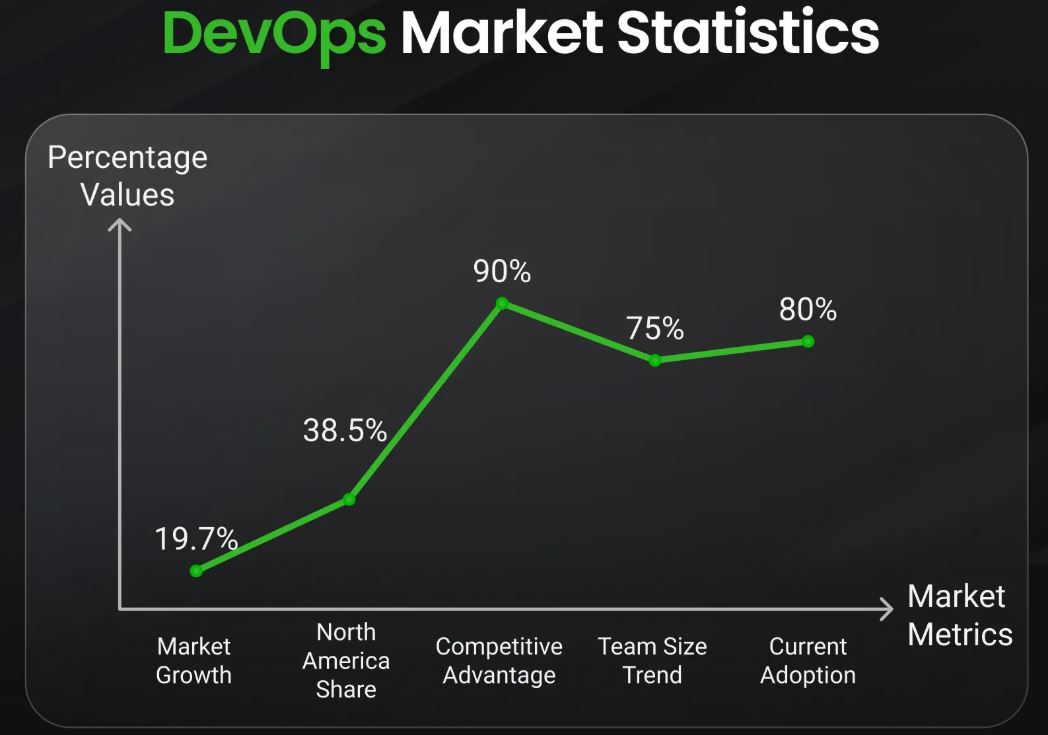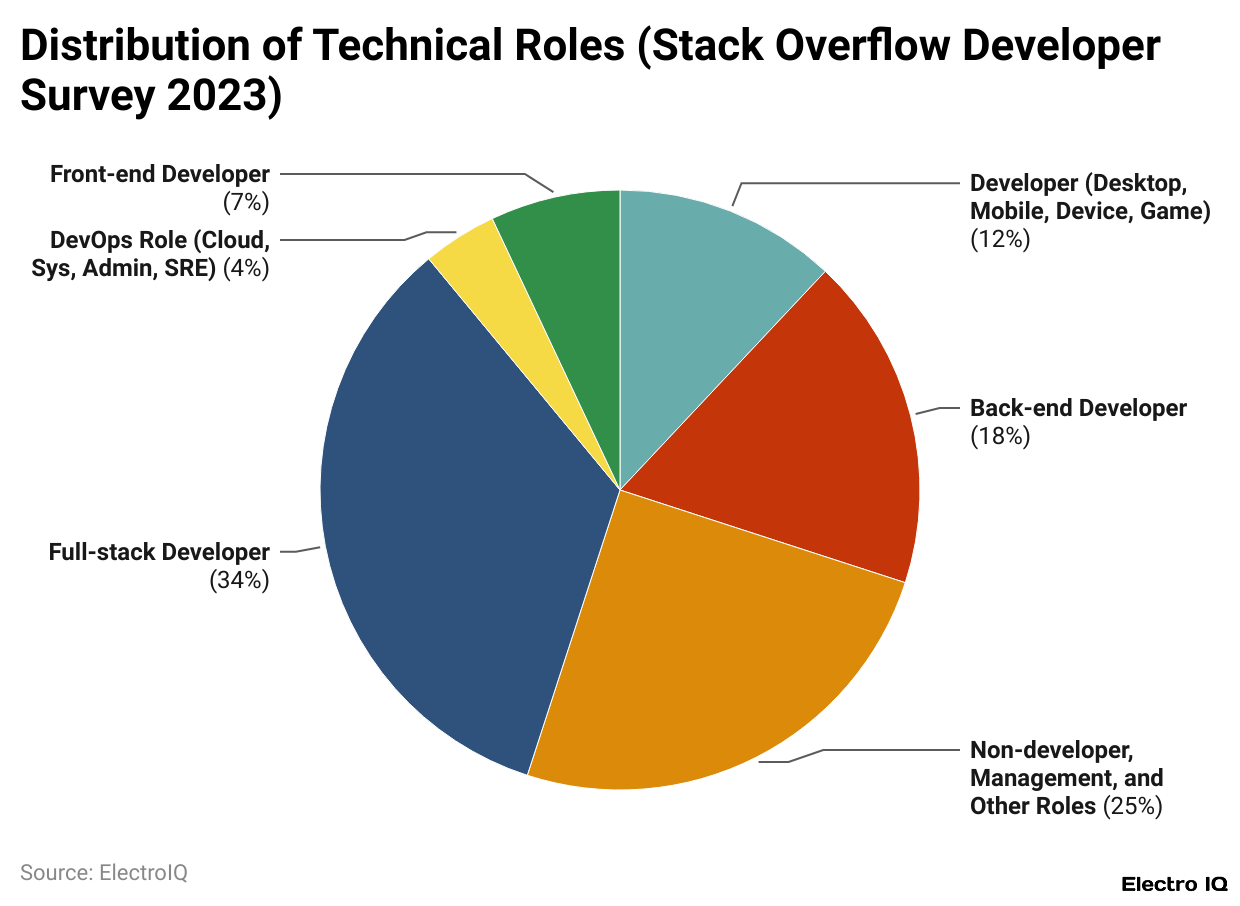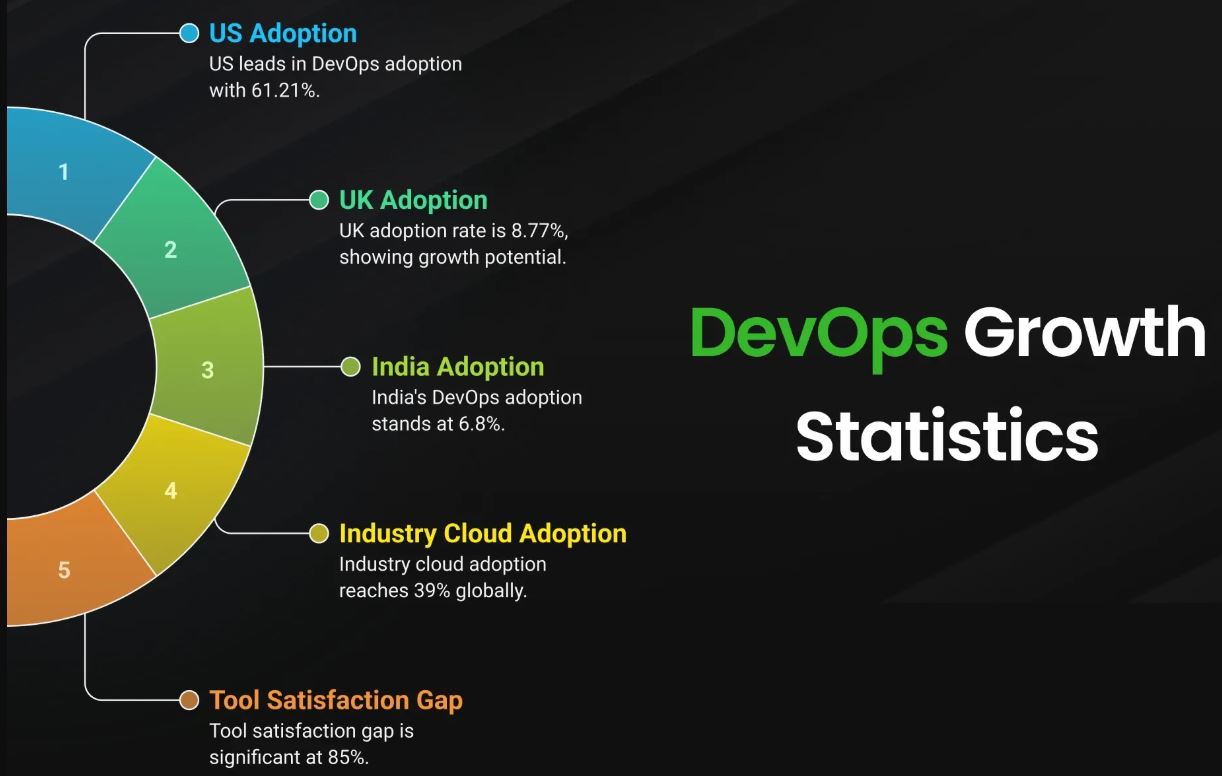DevOps Statistics and Facts, By Market, Engineer, Tools, Usage and Growth (2025)
Updated · Aug 27, 2025

Table of Contents
Introduction
DevOps Statistics: DevOps has been a portmanteau for development and operations. It is about bringing better ways to write, test, deploy, and maintain software. In 2024, DevOps is no longer just a toolset for operations; it is all set to change the ways teams and companies work.
Consequently, the article has been divided into multiple parts to discuss the DevOps statistics in 2024, adoption rates, market sizes and growth, performance metrics, and CI/CD pipeline.
Editor’s Choice
- The global DevOps market started with a US$4-billion valuation in 2019 and grew to US$10.4 billion in 2023, with projections hitting US$25.5 billion in 2028, CAGR 19.7%.
- On-premise DevOps has the potential to hit US$45 billion by 2032, owing to privacy and security concerns, whereas cloud options remain dominant.
- North America almost equals 38.5% of market share, whereas Asia-Pacific is likely to grow at 25% until 2028.
- About 90+% of companies believe that in order to stay competitive, DevOps needs to be maintained; 94% of organisations will probably finish adopting DevOps by 2025.
- The average annual salary for a DevOps engineer in the U.S.A. is stated US$103,571; the top 10% are above US$134,000 at present, with 11,029 DevOps engineers employed in the country.
- Jenkins holds the largest share at 46.35% of the CI/CD market, with Bitbucket at 18.61%, followed by CircleCI at 5.72%.
- Organisations that are adopting AI for their DevOps practices have a 45% higher change success rate, while Kubernetes is there to serve 48% of container-based organisations.
- Having a CI/CD pipeline is the norm for 80% of the enterprises, with 85% of companies running DevOps claiming CI/CD to be a standard in the process.
- Delivery times may see a 40% drop if the entire CI/CD pipeline is automated, and deployment stability and frequency may go up by 70%.
- DevOps teams using CI/CD and version control are 2.5 times faster in software delivery and 1.4 times more likely to achieve their performance targets.
- In 29% of recent times, various IT teams have hired a DevOps engineer, making it the most sought-after IT role, although 37% of leaders still perceive a gap in DevOps skills.
- In 2023, 68% of IT teams present DevOps upskilling programs, compared to 30% in 2020.
- U.S. leads in adoption, with 132,180 companies using DevOps tools, followed by the U.K. (18,950) and India (14,685).
- The Q1 2023 results show that Microsoft Azure DevOps revenue is growing by 31.8%, showing that the platform is being widely accepted.
- According to Google, 86% of organisations agree that there is a need for speedy software delivery and realise DevOps as an answer.
DevOps Market Statistics

(Source: tsttechnology.io)
- The DevOps market has been expanding rapidly over the last few years.
- It was worth more than US$4 billion already in 2019 and had more than doubled to US$10.4 billion by 2023.
- The good momentum is going to continue, with predictions saying it will hit US$25.5 billion by 2028, growing at a CAGR of 19.7% during that time.
- However, the main driver behind this growth is the increased demand for quicker delivery of software.
- The on-premise DevOps segment is also expected to register significant growth alongside online solutions, perhaps touching US$45 billion by 2032, as concerns regarding privacy and data security push some organisations to keep their operations at home.
- By region, currently, North America is the largest market, holding 38.5% of the global share in 2023. The Asia-Pacific market is also gaining momentum, with a 25% growth forecast by 2028, reflecting strong adoption trends.
- Certain countries feature distinct trends: in Germany, as of 2021, the IT and telecom sector accounted for roughly 30% of the DevOps market, while large enterprises in the DevOps sector in Brazil are projected to grow by 20% CAGR through 2028.
- In the year 2020, the European DevOps software tools market size was valued at around US$2.8 billion+, and since then, it has been witnessing consistent double-digit growth.
- Globally, 90% of companies in the last few years believe DevOps-based solutions can keep them ahead in competition.
- In the US alone, management-centric DevOps solutions controlled about 65% of the market share in 2021, and that has been increasing further.
DevOps Engineer Statistics
- There has been so much demand placed on DevOps engineers that it has almost led to fierce competition among companies to lure the best talent.
- US-based DevOps engineers are receiving an average annual pay of US$103,571, with the top 10% earning US$134,000 upwards.
- Some of the cities where most of the DevOps engineers are still identified are Atlanta, Georgia, and New York, New York, the best destination for job demand from DevOps engineers in the country.
- 11,029 DevOps engineers currently practice their skills in the United States alone.
- Regarding demographics, 56% are white, Asians make up 28.7%, and Hispanics or Latinos constitute 7.2%.
- Women, at that time, only accounted for 16.1%, while 75.7% were men; in these roles, women earned 93% of what men did in 2021.
- The average age of a DevOps engineer is 39 years, suggesting a combination of highly experienced professionals and mid-career talent in this field.
DevOps And Other Popular Tool Statistics
- The worldwide DevOps market, valued at US$10.9 billion in 2023, is expected to rise to US$63.4 billion by 2032, indicating just how important DevOps methodologies and tools like GitHub have become.
- Incorporating AI and machine learning into DevOps, particularly test automation, has proven efficient; companies using these technologies enjoy a 45% improvement in change success rate, i.e., quicker development cycles with fewer defects.
- Kubernetes remains number 1 in container orchestration, used by approximately 48% of containerised organisations.
- Jenkins, too, has experienced remarkable growth; the number of Pipeline users surged 79% between June 2021 and June 202,3 as compared to 45% in growth across all Jenkins workloads during the same time frame.
- Docker also remains the most popular container platform, used by more than half of enterprises out there.
- In cloud architecture, 70% of new applications are now developed using cloud-native technologies, and the biggest players in this sphere are AWS, Azure, and Google Cloud.
DevOps CI/CD Statistics

(Source: radixweb.com)
- Jenkins remains the most famous CI/CD tool, with 46.35% of the market share. It is then followed by Bitbucket with 18.61%, with CircleCI capping the top three at 5.72%.
- Mabl surveyed on DevOps statistics with 500 testers found that about 53% of teams use Continuous Integration, 38% Continuous Delivery, but only about 29% have reached full Continuous Deployment, implying that many teams are still in the early stages of maturity in DevOps.
- Analysis by DORA states that these teams practising CI/CD combined with version control are 2.5 times faster in delivering software than traditional teams.
- Top-performing teams that use these tools have a 1.4-times higher likelihood of achieving their performance targets and keeping customers happy.
- Security features will continue to be built into the early stages of the CI/CD process by 40% of organisations by 2026.
- The market for continuous integration tools was valued at around USD 970.5 million in 2022 and is expected to reach USD 4.38 billion by 2031, registering a staggering 18% CAGR during the forecast period.
- The value of US$802.2 million in 2021 was placed on the CI tools market, with an expectation of the market reaching US$3.76 billion by 2030.
- Survey information from early 2024 shows 29% of developers doing continuous integration to automate building and testing, with a further 27% adopting continuous deployment as the faster way to deliver code.
- Continuous integration and continuous delivery are now among the five most prevalent DevOps practices.
- That is to say, according to the 2024 State of CI/CD report, if too many CI/CD tools are used simultaneously, the deployments will tend to slow down.
- A GitLab report on DevOps statistics discloses that 60% of organisations using CI/CD could release their code at least twice as fast as they did.
- The CI tool market is projected to grow from US$2.27 billion in 2024 to US$5.3 billion in 2028.
- About 80% of companies have developed CI/CD pipelines to reduce release times and halve human errors, whereas 85% of companies with DevOps workflows consider CI/CD as a key part of their process.
- Projected to almost double by 2030, the overall CI/CD market is expected to grow with an annual rate of around 11%, valued US$10-12 billion in 2024.
- Automating CI/CD pipelines results in a reduction of delivery time of up to 40% while increasing deployment stability and frequency by about 70%.
- Mature DevOps teams witness deployment rates improving by 25% with a reduction of 20% in failed changes, lessened recovery time by 30%, and 28% in productivity through the CI/CD automation.
- AI-assisted continuous delivery, by the year 2025, is going to be implemented by some 60% of companies to increase failures and automation.
- Security is also an emerging fort: 55% of enterprises pay heed to DevSecOps, whereas a mere 12% of SMBs scan for security issues at every commit.
- 85% of the largest tech companies employ CI/CD pipelines for producing their main product.
- GitOps is expected to be utilised by 80% of organisations by 2025, and this will result in a 35-40% reduction in deployment times.
- Nearly 20% of organisations deploying CI/CD for cloud-native apps will be moving to NoOps, i.e., fully automated operations.
- At the same time, 40% of enterprises are struggling to apply CI/CD to legacy systems, and 55% are now concerned with pipeline security.
DevOps Usage Statistics
- An Atlassian survey on DevOps statistics found that DevOps has had strong positives on organisations, with 99% of respondents reporting benefits.
- Some 78% found new skills learned through DevOps, and 48% claimed the help in earning them an increase in salary.
- Additionally, many respondents noted actual work improvements, with 61% sharing that it helped with ensuring escalated quality of deliverables, whereas 49% noted it made release experiments easier.
- Adoption of DevOps is on a very high growth curve, with 94% of organisations predicted to have adopted DevOps practices by the end of 2025, as against around 80% in recent years.
- This will, in turn, drive the global market to go beyond the valuation of US$25 billion in 2025, owing to automation, cloud adoption, and the need for faster delivery.
- Most of the adoption is being carried out in the software and hardware sectors, accounting for 39% of the users, but the magic is stirring healthcare, non-profit, energy, and finance industries too.
- Mid-size companies (100–249 employees) employ most DevOps engineers.
- Almost 75% of DevOps teams consist of 12 or fewer members, enabling them to stay nimble and responsive.
- Approximately 85% are moving toward a shared services model for better collaboration.
- The average age of a DevOps engineer is 39 years, and the workforce comprises 75.7% males and 16.1% females.
- Public clouds have always remained the prime location for running DevOps workloads.
- Another problem from the expense-tracking perspective is that the organisations’ cloud costs are being tracked properly by only 30% of the organisations.
- On tooling, Jenkins commands the CI/CD space with a 46.35% share, followed by Bitbucket at 18.61% and CircleCI closing in at 5.72%.
- The CI tool market was worth US$2.27 billion in 2024 and is expected to reach US$5.3 billion by 2028; however, too many tools simultaneously reduce their performance.
- The average pay for a DevOps engineer in the United States is US$103,571 per year, while the top 10% bring it up to US$134,000 or more per year.
- Currently, 11,029 are employed in this capacity, mainly in New York and Atlanta.
- From a performance point of view, DevOps teams that use CI/CD and version control deliver 2.5 times faster than traditional teams, and top-performing teams are 1.4 times more likely to hit their targets and satisfy clients.
- Organisations with strong DevOps cultures spend 33% more time on improving systems compared to fixing problems.
DevOps Engineer Hiring Statistics

(Reference: brokee.io)
- DevOps engineers are the single most sought-after professionals in the IT space. Since almost 29% of IT teams have been able to recruit DevOps engineers, that is quite a big number.
- However, 37% of IT headship still considers that their teams do not have any DevOps or DevSecOps skills, thus labelling the biggest technical skills gap they have to face.
- Now, 68% of IT teams are trying to bridge that gap with upskilling programs-an uptrend from just 30% in 2020.
- According to Statista, DevOps is ranked among the seventh most desired tech skills developers want to learn.
- On the hiring side of the fence, recruitment agencies are facing difficulties, with 19% of them saying they are having a tough time locating experienced DevOps professionals.
DevOps Growth Statistics

(Source: tsttechnology.io)
- In 2023, the DevOps market was valued at approximately US$10.4 billion, and it has been growing steadily over the years.
- According to IDC, in 2020, the DevOps software tools accounted for a revenue of US$2.8 billion from Europe alone.
- By 2021, Global Industry Analysts Inc. predicted the market at US$17.6 billion by 2026.
- By 2023, 85% of DevOps teams used more than one observability tool; however, only 14% were satisfied with their Mean Time to Resolve (MTTR).
- The U.S. leads in adoption, with around 61.21% (or 132,180 companies) using DevOps tools.
- The United Kingdom stands second, accounting for 8.77% (18,950 companies), whereas India comes third with 6.8% (14,685 companies) actively utilising DevOps services and tools.
- However, Gartner threatens to say spinning up DevOps into a scaling machine too quickly may sometimes diminish efficiency instead of enhancing it.
- Currently, Microsoft Azure DevOps revenue has experienced robust growth of 31.8% in Q1 2023.
- The targeted DevOps tools market for the automatic software build and test is expected to reach US$2.276 billion by 2030, at a growth rate of 11% CAGR between 2022 and 2030.
- Gartner has claimed that about 39% of organisations have adopted industry cloud platforms (many of which stand on a DevOps foundation) and that a further 17% are expected to have adopted them by 2026.
- Also outlined by Gartner, 15% of companies were still in the planning stage for the adoption of DevOps, whereas 9% were yet to even start on it, which gives enough room to grow into it in the future.
- Google opined that 86% of companies are cognizant of the need for quick deliveries in software and recognise DevOps as their best help to achieve that goal.
Conclusion
DevOps Statistics: DevOps continues to alter the procedure of organisations in building, deploying, and managing their software with fast delivery, better quality, and high performance. With the market worldwide expected to cross US$25 billion by 2028, the adoption is growing fast across verticals and is most active in North America and Asia-Pacific.
The future of DevOps will be defined by CI/CD, AI integration, and platform engineering. Upskilling is rising despite growing skill gaps. Automation and security will be the talk of the town for a while. Hence, DevOps will continue to be at the forefront of innovation and competitive leverage in the evolving digital world.
Sources
FAQ.
The worldwide DevOps market expanded from over US$4 billion in 2019 to US$10.4 billion in 2023 and is expected to touch US$25.5 billion by 2028 at a CAGR of 19.7%. Moreover, the on-premise DevOps may hit US$45 billion by 2032 because of privacy and security issues.
Jenkins retains a huge 46.35% share of the CI/CD market, followed by Bitbucket with 18.61% and CircleCI with 5.72%. Almost 80% of companies have CI/CD pipelines, and automation may reduce delivery times by 40% and increase stability by 70%.
In nearly all organisations, i.e., 94%, DevOps adoption is expected to occur by 2025, and 99% of the users report benefits in terms of better-quality deliverables, faster release cycles, and better collaboration. Organisations employing CI/CD with version control systems deliver 2.5 times faster and are also 1.4 times more likely to accomplish their performance targets.
The DevOps market is a better one for jobs. DevOps engineers are some of the most sought-after IT professionals, with 29% of IT teams recently hiring for this position. The annual average salary is US$103,571, and the top 10% can stand to make US$134,000 and up. There are about 11,029 DevOps engineers in the U.S., with most based in New York and Atlanta.
Countries in the U.S. take the lead in DevOps adoption, with around 132,180 companies using DevOps toolsets, followed by the U.K. (at 18,950) and India (14,685). The Microsoft Azure DevOps platform has had a revenue increase of 31.8% in the first quarter of 2023, showing strong growth in the platform.

I hold an MBA in Finance and Marketing, bringing a unique blend of business acumen and creative communication skills. With experience as a content in crafting statistical and research-backed content across multiple domains, including education, technology, product reviews, and company website analytics, I specialize in producing engaging, informative, and SEO-optimized content tailored to diverse audiences. My work bridges technical accuracy with compelling storytelling, helping brands educate, inform, and connect with their target markets.










